Augmented Reality’s Impact on English Vocabulary and Content Acquisition in the CLIL Classroom
Abstract
Featured Application
Abstract
1. Introduction
2. Materials and Methods
2.1. Study Design and Setting
2.2. Participants and Context
2.3. Materials
2.4. Instruments
- Productive vocabulary: fill-in-the-gap exercises plus picture–word matching.
- Receptive vocabulary: multiple-choice questions.
2.5. Procedure
2.6. Data Analysis
2.7. Ethics and Transparency
2.8. Availability of Materials
3. Results
3.1. Socio-Demographic Characteristics of Participants
3.2. Technological Affinity and Patterns of Digital Use
3.3. Attitudes Toward AR Technology (Pre/Post)
3.4. Vocabulary and Content Learning Outcomes
3.5. Summary of Key Findings
- (1)
- Sample profile. The cohort was balanced across conditions (EG = 64; CG = 65) and linguistically diverse, with Spanish predominant. Overall English proficiency clustered around B1, with writing comparatively lower (≈high A2). These patterns align with links between engagement/knowledge and mobile-AR performance [23] and with diverse certification pathways [24]; gender representation effects are consistent with Gómez-Trigueros and Yáñez de Aldecoa [24].
- (2)
- Technology access and platforms. Students reported high access and use of smartphones and strong familiarity with mainstream platforms (e.g., Instagram, TikTok, YouTube), while tablets were least used (M = 1.2) and laptops moderate (M = 2.5). Device-level attitudes mirrored prior work showing positive sentiments toward certain tools and in our data smartphones/laptops received the most favorable feedback.
- (3)
- Perceptions of AR vs. theoretical materials. Post-survey means were similar for AR and theoretical materials (both M = 3.1), but variability was greater for AR (SD = 1.1) than for theoretical materials (SD = 0.7), indicating more divergent experiences with AR. Thus, AR was generally well-received yet more heterogeneous, whereas theoretical materials produced steadier satisfaction.
- (4)
- Vocabulary/content learning at item level. Item-level tests identified significant effects for several prompts (e.g., ‘A peak is…,’ ‘to give up…,’ ‘A predator is…,’ ‘Wilderness can be found in…,’ ‘This picture represents…’) with associated Z and Sig. values reported. Where prompts did not reach significance (e.g., ‘To bring forward…,’ ‘This animal is…’), the pattern suggests the need for additional scaffolding or extended practice windows in CLIL-AR tasks.
4. Discussion
4.1. Principal Findings and Interpretation
4.2. Relation to Previous Studies and Theoretical Framing
- (a)
- (b)
- Effects are task-dependent rather than uniform [4].
4.3. Pedagogical Implications for CLIL
- Support teachers. Although ease-of-use ratings were high, lightweight training (marker handling, pacing, troubleshooting) is advisable, so classroom time remains cognitively productive [13,14,15,17]. These implications reflect our study’s findings that AR was most effective for visually scaffolded vocabulary and content, aligning with the CLIL 4Cs framework and Cognitive Load Theory by emphasizing meaningful, manageable, and integrated learning experiences.
4.4. Methodological Considerations
4.5. Future Research Directions
5. Conclusions
Author Contributions
Funding
Institutional Review Board Statement
Informed Consent Statement
Data Availability Statement
Conflicts of Interest
Appendix A
| Descriptive Statistics | M | SD |
|---|---|---|
| 1. Gender | 1.5 | 0.5 |
| 2. Language Spoken | 1.6 | 1.3 |
| 3. Mother Tongue | 2.0 | 1.9 |
| 4. Group | 2.1 | 1.2 |
| 5. Age | 1.5 | 0.5 |
| 6. General English Level | 3.0 | 1.1 |
| 7. Speaking Level | 3.0 | 1.2 |
| 8. Listening Level | 3.2 | 1.2 |
| 9. Reading Level | 3.2 | 1.2 |
| 10. Writing Level | 2.9 | 1.1 |
| 11. Type of English Certificate | 2.0 | 2.5 |
| Descriptive Statistics | N | M | SD |
|---|---|---|---|
| 1. Continue the sentence. “A peak is…” | 115 | 0.89 | 0.32 |
| 2. Continue the sentence. “to give up is…” | 115 | 0.87 | 0.34 |
| 3. Continue the sentence. “A predator is…” | 115 | 0.90 | 0.30 |
| 4. Continue the sentence. “To bring forward is…” | 115 | 0.60 | 0.49 |
| 5. Continue the sentence. “Wilderness can be found in…” | 115 | 0.89 | 0.32 |
| 6. This is a… | 115 | 0.98 | 0.13 |
| 7. This animal is… | 115 | 0.98 | 0.13 |
| 8. This picture represents… | 115 | 0.29 | 0.45 |
| 9. This picture represents… | 115 | 0.54 | 0.50 |
| Descriptive Statistics | M | SD |
|---|---|---|
| 1. Ownership of their own devices | 2.8 | 0.4 |
| 2. Age 1st smartphone | 2.9 | 0.8 |
| 3. TikTok frequency | 3.9 | 1.4 |
| 4. Instagram frequency | 4.1 | 1.1 |
| 5. Snapchat frequency | 1.2 | 0.6 |
| 6. Twitter frequency | 2.1 | 1.3 |
| 7. Tumblr frequency | 1.0 | 0.4 |
| 8. Facebook frequency | 1.1 | 0.4 |
| 9. YouTube frequency | 3.6 | 1.0 |
| 10. Pinterest frequency | 2.2 | 1.2 |
| 11. Kik frequence | 1.0 | 0.1 |
| 12. Discord frequence | 2.1 | 1.2 |
| 13. Others frequence | 1.7 | 1.3 |
| 14. Videogames | 2.9 | 1.2 |
| 15. Smartphone usage | 3.3 | 1.1 |
| Items | M | SD |
|---|---|---|
| 1. AR improves performance | 3.4 | 0.9 |
| 2. AR improves academic productivity | 3.4 | 0.9 |
| 3. AR makes learning easier | 3.6 | 0.8 |
| 4. AR is easy to use | 3.4 | 1.0 |
| 5. Learning how to use AR is easy | 3.6 | 0.9 |
| 6. It is easy to become SKILLFUL at AR | 3.4 | 0.9 |
| 7. Studying with AR is a good idea | 3.5 | 0.9 |
| 8. Studying with AR is a wise idea | 3.3 | 1.0 |
| 9. Students are positive towards AR | 3.6 | 0.9 |
| 10. Students intend learning more about AR | 3.3 | 1.0 |
| 11. Students intend to be frequent users of AR | 2.8 | 0.9 |
| 12. Students have confidence to learn via AR | 3.3 | 0.9 |
| 13. Students have necessary skills for using AR | 3.2 | 0.1 |
| 14. Students enjoy AR based on their own experience | 3.4 | 0.9 |
| 15. Students believe AR knowledge is needed for future jobs | 3.2 | 1.1 |
| 16. Students have no difficulty accessing and using AR | 3.1 | 1.0 |
| Descriptive Statistics | M | SD |
|---|---|---|
| 1. How easy was using AR during the experiment for you? [How was using AR technology?] | 3.89 | 0.8 |
| 2. How easy was using AR during the experiment for you? [How engaging was AR applied to the experiment?] | 3.38 | 0.7 |
| 3. How easy was using AR during the experiment for you? [How interesting was the use of AR applied to experiment?] | 3.3 | 0.9 |
| 4. How easy was using AR during the experiment for you? [How intuitive was using AR applied to the experiment?] | 3.8 | 0.8 |
| 5. How easy was using AR during the experiment for you? [How problematic was following the steps during the experiment?] | 3.4 | 0.9 |
| 6. Is it likely you will try AR again after the experiment for your own interest? | 2.9 | 1.3 |
| 7. How convenient is using each of these devices for learning with AR? [smartphones] | 3.5 | 1.1 |
| 8. How convenient is using each of these devices for learning with AR? [tablets] | 3.7 | 1.1 |
| 9. How convenient is using each of these devices for learning with AR? [laptops] | 3.4 | 1.1 |
| 10. How do you feel about the use of the following devices in your classes for EDUCATIONAL purposes after having had the experience during the experiment? [smartphone] | 3.5 | 1.0 |
| 11. How do you feel about the use of the following devices in your classes for EDUCATIONAL purposes after having had the experience during the experiment? [tablet] | 3.7 | 1.1 |
| 12. How do you feel about the use of the following devices in your classes for EDUCATIONAL purposes after having had the experience during the experiment? [laptop] | 3.8 | 1.3 |
| 13. Have you used AR after the experiment? | 0.5 | 0.5 |
| 14. How interested are you in using AR technology in your classes after having used it during the experiment? | 3.2 | 1.1 |
| 15. How easy was using AR during the experiment for you? [How was using AR technology?] | 3.89 | 0.8 |
| 16. How easy was using AR during the experiment for you? [How engaging was AR applied to the experiment?] | 3.38 | 0.7 |
| 17. How did you feel after using AR during the experiment? | 3.1 | 1.1 |
| 18. How did you feel after using THEORETICAL MATERIALS during the experiment? | 3.1 | 0.7 |
| Language Test Results | Z | p | r (Effect Size) |
|---|---|---|---|
| 1. Continue the sentence. “A peak is…” | −3.21 | 0.0 | 0.28 |
| 2. Continue the sentence. “to give up is…” | 0.0 | 1.0 | 0.00 |
| 3. Continue the sentence. “A predator is…” | −1.5 | 0.1 | 0.13 |
| 4. Continue the sentence. “To bring forward is | −1.2 | 0.2 | 0.10 |
| 5. Continue the sentence. “Wilderness can be found in…” | −2.5 | 0.0 | 0.22 |
| 6. This is a… | −1.4 | 0.1 | 0.12 |
| 7. This animal is… | 0.0 | 1.0 | 0.00 |
| 8. This picture represents… | −2.6 | 0.0 | 0.23 |
| 9. This picture represents… | −3.1 | 0.0 | 0.27 |
Appendix B

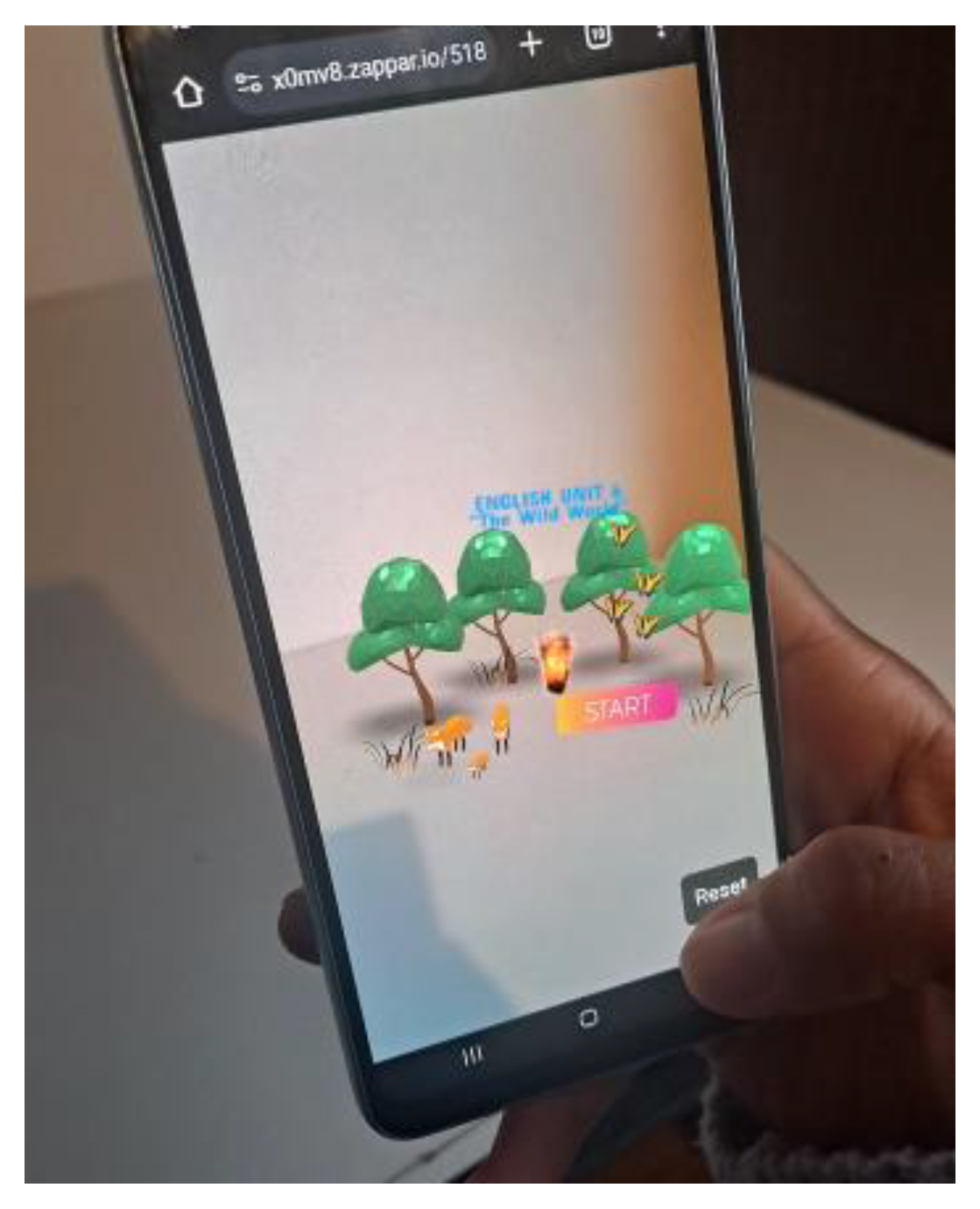
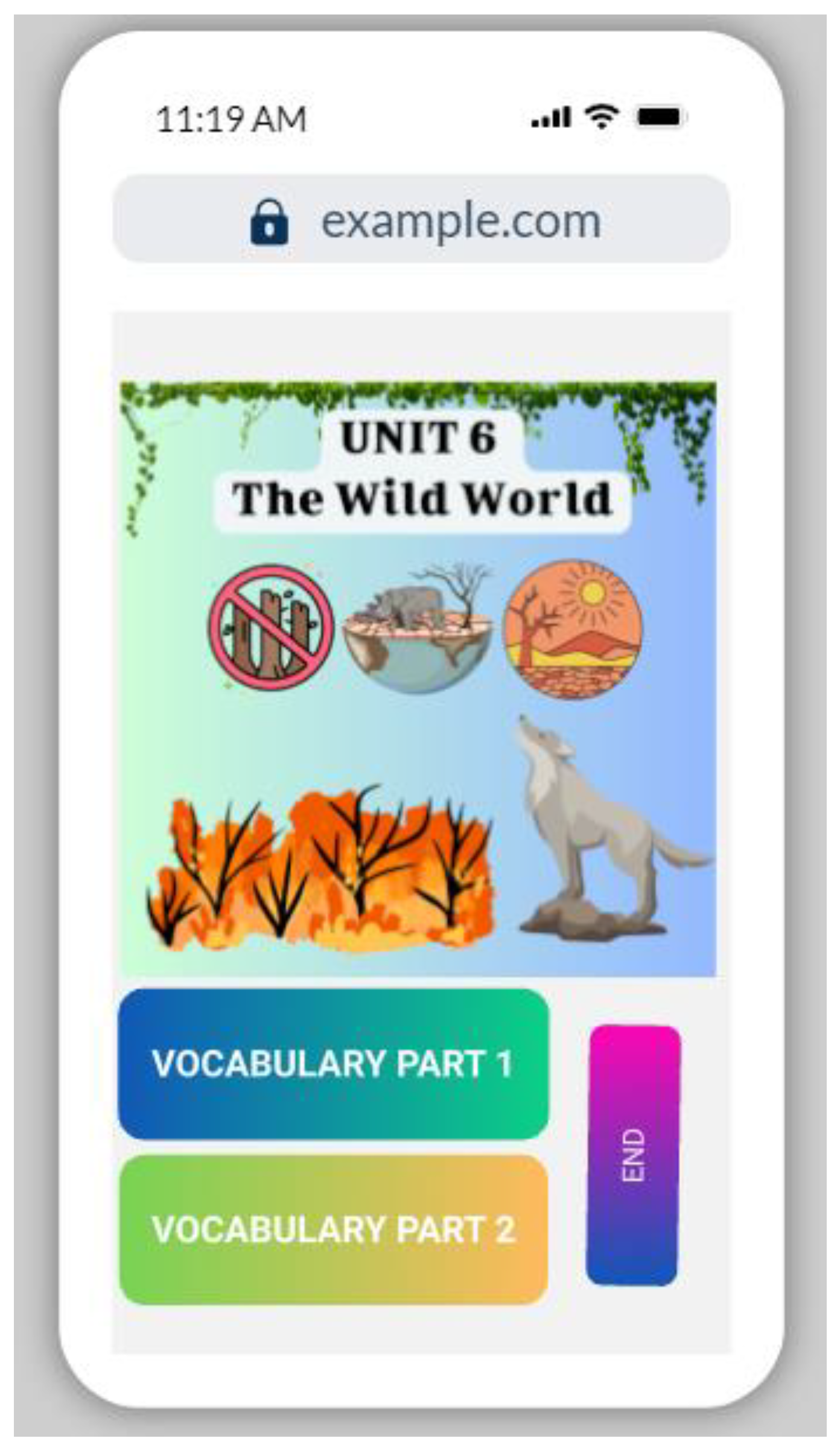
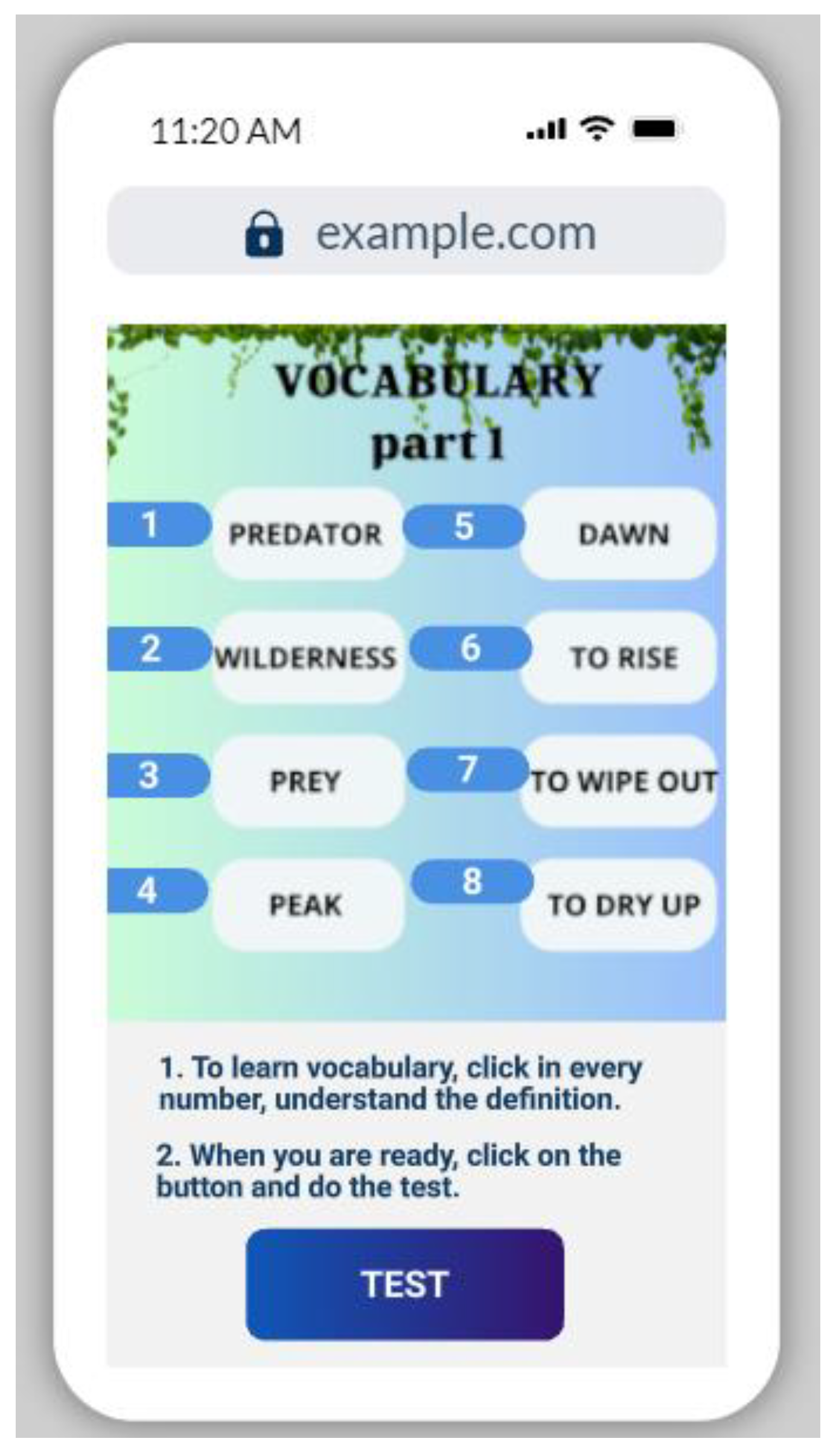
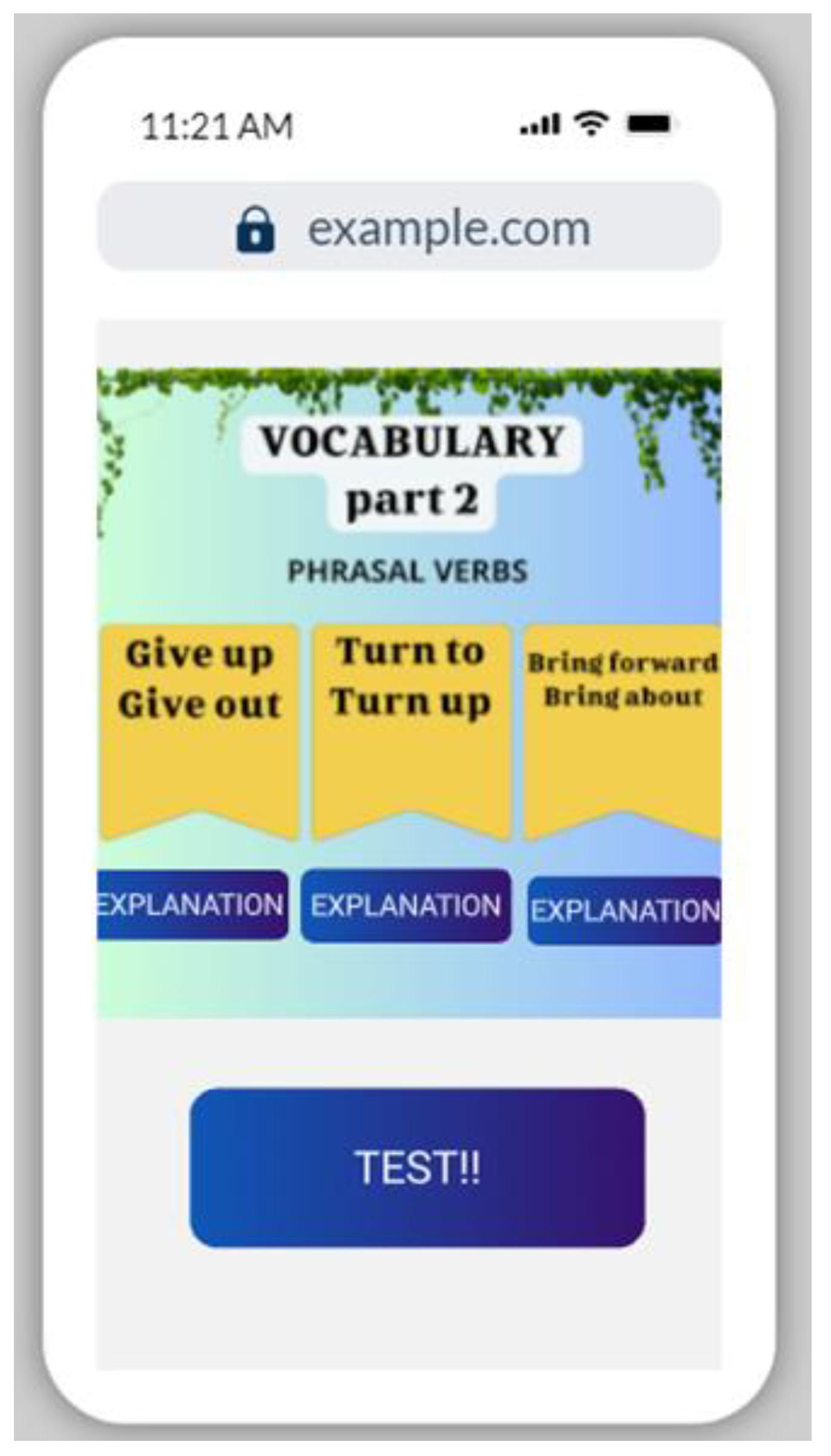
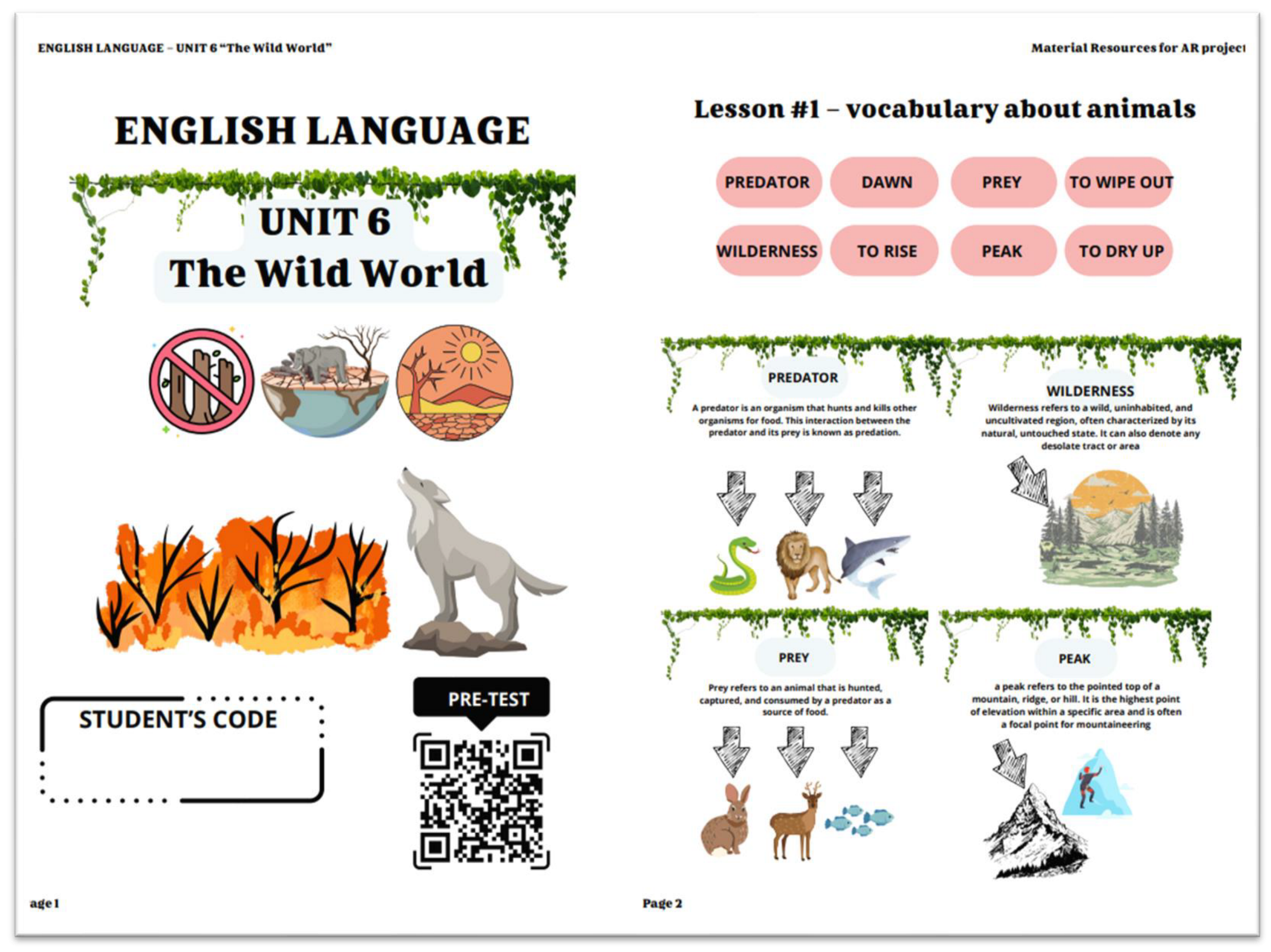
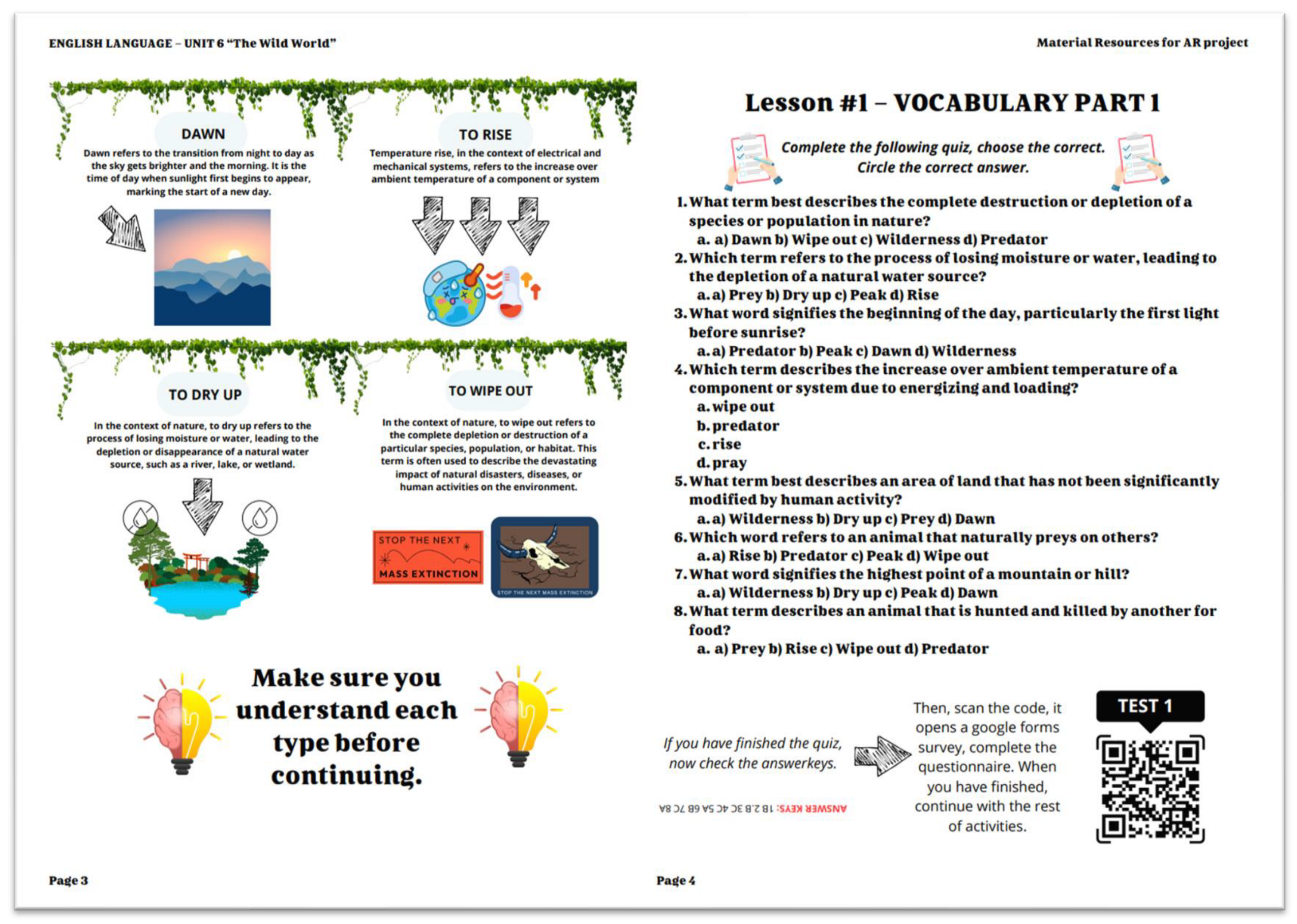
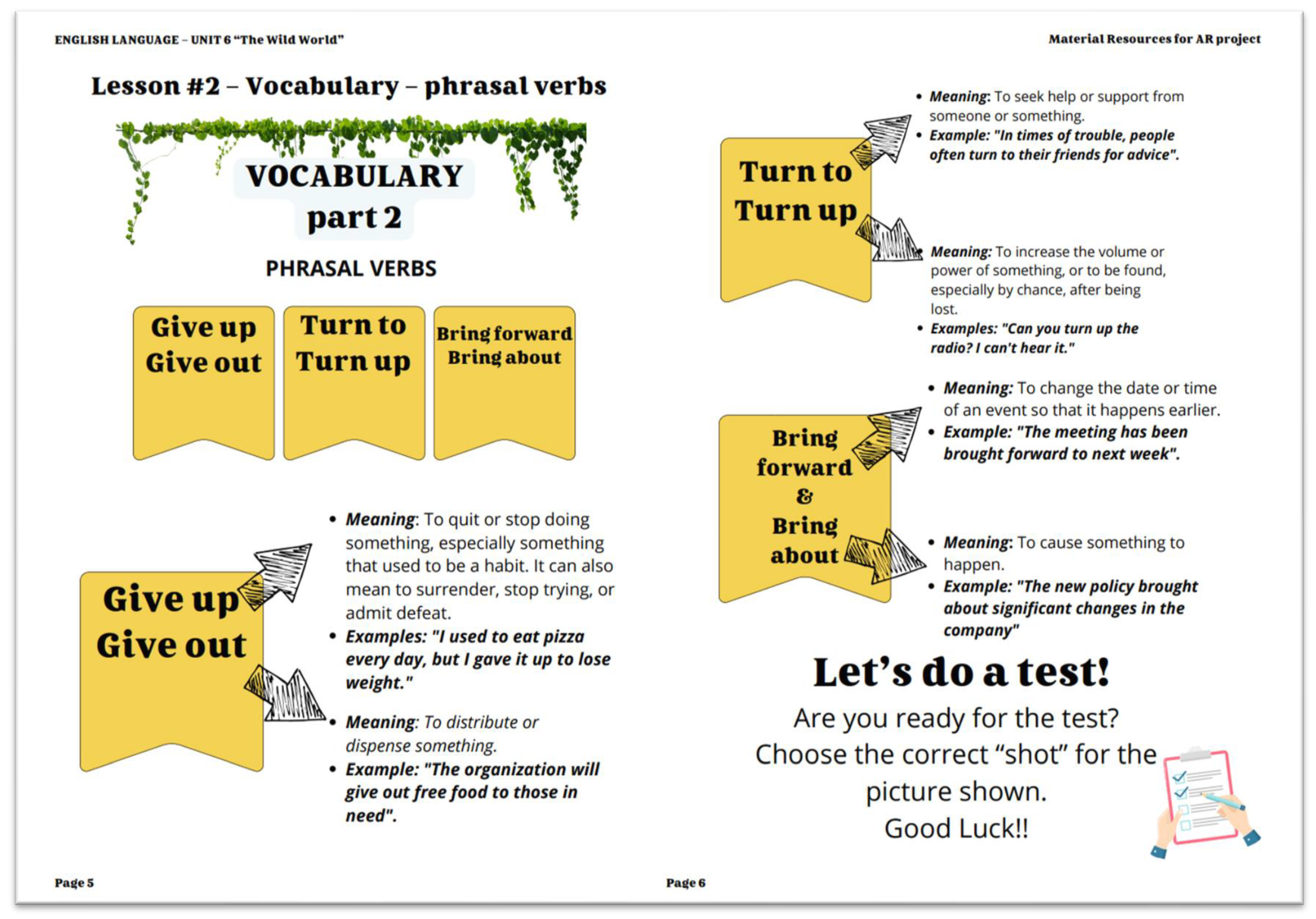

References
- Garzón, J.; Acevedo, J. Meta-Analysis of the Impact of Augmented Reality on Students’ Learning Gains. Educ. Res. Rev. 2019, 27, 244–260. [Google Scholar] [CrossRef]
- Huang, X.; Zou, D.; Cheng, G.; Xie, H. A Systematic Review of AR and VR Enhanced Language Learning. Sustainability 2021, 13, 4639. [Google Scholar] [CrossRef]
- Solak, E.; Cakir, R. Exploring the Effect of Materials Designed with Augmented Reality on Language Learners’ Vocabulary Learning. J. Educ. Online 2015, 12, 50–72. [Google Scholar] [CrossRef]
- Wu, H.-K.; Lee, S.W.-Y.; Chang, H.-Y.; Liang, J.-C. Current Status, Opportunities and Challenges of Augmented Reality in Education. Comput. Educ. 2013, 62, 41–49. [Google Scholar] [CrossRef]
- Bacca Acosta, J.L.; Baldiris Navarro, S.M.; Fabregat Gesa, R.; Graf, S. Augmented Reality Trends in Education: A Systematic Review of Research and Applications. J. Educ. Technol. Soc. 2014, 17, 133–149. [Google Scholar]
- Khoshnevisan, B.; Le, N. Augmented Reality in Language Education: A Systematic Literature Review. Adv. Glob. Educ. Res. 2018, 2, 57–71. [Google Scholar]
- Parmaxi, A.; Berns, A.; Adinolfi, L.; Gruber, A.; Fominykh, M.; Voreopoulou, A.; Wild, F.; Vassiliou, P.; Christou, E.; Valero-Franco, C. Augmented Reality in Language Learning: Practical Implications for Researchers and Practitioners. In Proceedings of the International conference on Human-Computer Interaction, Washington, DC, USA, 29 June–4 July 2024; Springer: Berlin/Heidelberg, Germany, 2024; pp. 138–154. [Google Scholar]
- Belda-Medina, J. Using Augmented Reality (AR) as an Authoring Tool in EFL through Mobile Computer-Supported Collaborative Learning. Teach. Engl. Technol. 2022, 22, 115–135. [Google Scholar]
- Belda-Medina, J.; Marrahi-Gomez, V. The Impact of Augmented Reality (AR) on Vocabulary Acquisition and Student Motivation. Electronics 2023, 12, 749. [Google Scholar] [CrossRef]
- Akçayır, M.; Akçayır, G. Advantages and Challenges Associated with Augmented Reality for Education: A Systematic Review of the Literature. Educ. Res. Rev. 2017, 20, 1–11. [Google Scholar] [CrossRef]
- Huertas-Abril, C.A.; Figueroa-Flores, J.F.; Gómez-Parra, M.E.; Rosa-Dávila, E.; Huffman, L.F. Augmented Reality for ESL/EFL and Bilingual Education: An International Comparison. Educ. XX1 2021, 24, 189–208. [Google Scholar] [CrossRef]
- Chen, R.W.; Chan, K.K. Using Augmented Reality Flashcards to Learn Vocabulary in Early Childhood Education. J. Educ. Comput. Res. 2019, 57, 1812–1831. [Google Scholar] [CrossRef]
- Chen, Y.; Smith, T.J.; York, C.S.; Mayall, H.J. Google Earth Virtual Reality and Expository Writing for Young English Learners from a Funds of Knowledge Perspective. Comput. Assist. Lang. Learn. 2020, 33, 1–25. [Google Scholar] [CrossRef]
- Tai, T.-Y.; Chen, H.H.-J.; Todd, G. The Impact of a Virtual Reality App on Adolescent EFL Learners’ Vocabulary Learning. Comput. Assist. Lang. Learn. 2022, 35, 892–917. [Google Scholar] [CrossRef]
- Tuli, N.; Mantri, A. Evaluating Usability of Mobile-Based Augmented Reality Learning Environments for Early Childhood. Int. J. Hum.-Comput. Interact. 2021, 37, 815–827. [Google Scholar] [CrossRef]
- Barreira, J.; Bessa, M.; Pereira, L.C.; Adão, T.; Peres, E.; Magalhães, L. MOW: Augmented Reality Game to Learn Words in Different Languages: Case Study: Learning English Names of Animals in Elementary School. In Proceedings of the 7th Iberian Conference on Information Systems and Technologies (CISTI 2012), Madrid, Spain, 20–23 June 2012; IEEE: New York, NY, USA, 2012; pp. 1–6. [Google Scholar]
- Chang, Y.-S.; Chen, C.-N.; Liao, C.-L. Enhancing English-Learning Performance through a Simulation Classroom for EFL Students Using Augmented Reality-A Junior High School Case Study. Appl. Sci. 2020, 10, 7854. [Google Scholar] [CrossRef]
- Geng, X.; Yamada, M. An Augmented Reality Learning System for Japanese Compound Verbs: Study of Learning Performance and Cognitive Load. Smart Learn. Environ. 2020, 7, 27. [Google Scholar] [CrossRef]
- Hsu, T.-C. Learning English with Augmented Reality: Do Learning Styles Matter? Comput. Educ. 2017, 106, 137–149. [Google Scholar] [CrossRef]
- Lee, J. Problem-Based Gaming via an Augmented Reality Mobile Game and a Printed Game in Foreign Language Education. Educ. Inf. Technol. 2022, 27, 743–771. [Google Scholar] [CrossRef]
- Wedyan, M.; Falah, J.; Elshaweesh, O.; Alfalah, S.F.; Alazab, M. Augmented Reality-Based English Language Learning: Importance and State of the Art. Electronics 2022, 11, 2692. [Google Scholar] [CrossRef]
- Lampropoulos, G.; Keramopoulos, E.; Diamantaras, K.; Evangelidis, G. Augmented Reality and Gamification in Education: A Systematic Literature Review of Research, Applications, and Empirical Studies. Appl. Sci. 2022, 12, 6809. [Google Scholar] [CrossRef]
- Chang, H.-Y.; Liang, J.-C.; Tsai, C.-C. Students’ Context-Specific Epistemic Justifications, Prior Knowledge, Engagement, and Socioscientific Reasoning in a Mobile Augmented Reality Learning Environment. J. Sci. Educ. Technol. 2020, 29, 399–408. [Google Scholar] [CrossRef]
- Gómez-Trigueros, I.M.; Yáñez de Aldecoa, C. The Digital Gender Gap in Teacher Education: The TPACK Framework for the 21st Century. Eur. J. Investig. Health Psychol. Educ. 2021, 11, 1333–1349. [Google Scholar] [CrossRef] [PubMed]

Disclaimer/Publisher’s Note: The statements, opinions and data contained in all publications are solely those of the individual author(s) and contributor(s) and not of MDPI and/or the editor(s). MDPI and/or the editor(s) disclaim responsibility for any injury to people or property resulting from any ideas, methods, instructions or products referred to in the content. |
© 2025 by the authors. Licensee MDPI, Basel, Switzerland. This article is an open access article distributed under the terms and conditions of the Creative Commons Attribution (CC BY) license (https://creativecommons.org/licenses/by/4.0/).
Share and Cite
Fernandez-Alcocer, M.; Belda-Medina, J. Augmented Reality’s Impact on English Vocabulary and Content Acquisition in the CLIL Classroom. Appl. Sci. 2025, 15, 10380. https://doi.org/10.3390/app151910380
Fernandez-Alcocer M, Belda-Medina J. Augmented Reality’s Impact on English Vocabulary and Content Acquisition in the CLIL Classroom. Applied Sciences. 2025; 15(19):10380. https://doi.org/10.3390/app151910380
Chicago/Turabian StyleFernandez-Alcocer, Mar, and Jose Belda-Medina. 2025. "Augmented Reality’s Impact on English Vocabulary and Content Acquisition in the CLIL Classroom" Applied Sciences 15, no. 19: 10380. https://doi.org/10.3390/app151910380
APA StyleFernandez-Alcocer, M., & Belda-Medina, J. (2025). Augmented Reality’s Impact on English Vocabulary and Content Acquisition in the CLIL Classroom. Applied Sciences, 15(19), 10380. https://doi.org/10.3390/app151910380







